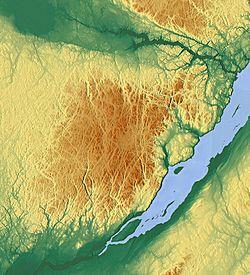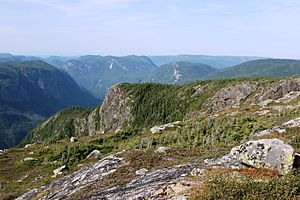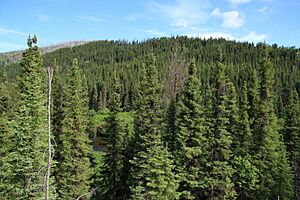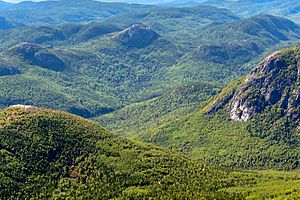Jacques-Cartier Massif facts for kids
Quick facts for kids Jacques-Cartier Lake Massif |
|
|---|---|

Topographic map of the massif.
|
|
| Highest point | |
| Peak | Mont Raoul Blanchard |
| Elevation | 1,181 m (3,875 ft) |
| Geography | |
| Country | Canada |
| Province | Quebec |
| Range coordinates | 47°23′02″N 71°13′02″W / 47.38389°N 71.21722°W |
The Lac Jacques-Cartier massif is the tallest mountain range in the Laurentian Mountains of Quebec, Canada. It sits between the St. Lawrence River and the Saguenay graben. This area has a high plateau, usually between 800 and 900 meters (about 2,600 to 3,000 feet) high. Its highest point is Mount Raoul Blanchard, which reaches 1,181 meters (about 3,875 feet) tall.
Contents
What's in a Name?
This mountain area is named after Jacques-Cartier lake. This lake is a glacial lake, meaning it was formed by glaciers long ago. It sits right in the middle of the massif.
Where is the Massif?

The Lac Jacques-Cartier massif covers most of the Capitale-Nationale region. This is a large area in Quebec. It also reaches into the very southern part of the Saguenay–Lac-Saint-Jean region.
What Does the Land Look Like?
The Jacques-Cartier Lake massif is a special part of the Laurentides mountain range. Along with the Valin Mountains, it stands much taller than other peaks in the chain.
This area is known for its hundreds of lakes. It also has several valleys carved out by glaciers, like the Jacques-Cartier River valley. These features make the massif unique.
Some of the main peaks in the massif include:
- Mount Raoul Blanchard (1,181 meters)
- Mount Belle Fontaine (1,151 meters)
- Mont de la Québécoise (1,112 meters)
- Montagne des Érables (1,048 meters)
- Mont Élie (1,038 meters)
Many other high points in this area are over 1,000 meters tall. However, not all of them have been officially named as mountains.
Plants and Animals of the Massif

The massif has a special boreal ecosystem. This type of environment is not found anywhere else at this latitude in Quebec. The most common tree you'll see here is the black spruce.
This mountain range is also home to one of the last groups of forest caribou in southern Quebec. This group is known as the Charlevoix herd. Protecting their home is very important.
Protecting This Natural Area
The Lac Jacques-Cartier massif is one of the last wild places in southern Quebec. Most of this land is public territory. It is protected by several important areas, including:
- The Laurentides Wildlife Reserve
- Jacques-Cartier National Park
- Grands-Jardins National Park
- Hautes-Gorges-de-la-Rivière-Malbaie National Park
These parks and reserves help keep the massif's unique nature safe for the future.


